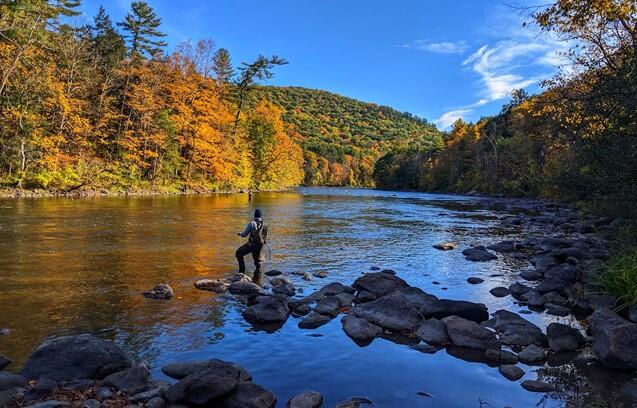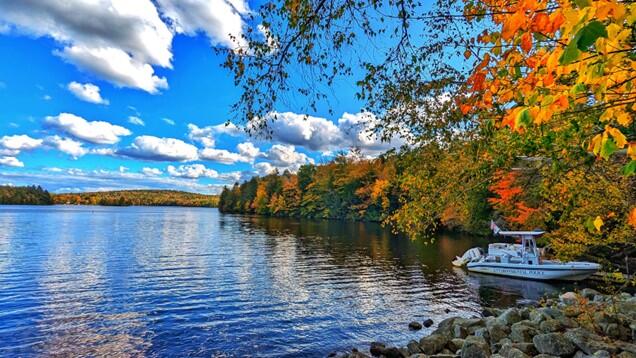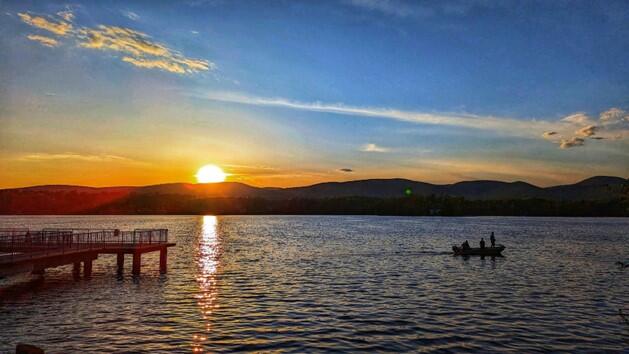- Trial Court Law Libraries

Pictured above: Fly Fishing on the Housatonic River. Invasive species damages local ecosystems and harms native species populations and therefore it is important to follow all laws and regulations.
Massachusetts is home to many beautiful lakes, rivers, and ponds that residents and visitors enjoy for fishing, boating, and swimming. However, these water bodies face threats from invasive species that can disrupt ecosystems, harm water quality, and hinder recreational activities. To combat these issues, The Commonwealth of Massachusetts has established specific laws, programs, and guides for the public aimed at controlling and managing these aquatic nuisances. Let's dive into what these laws and resources are and how they help keep our water bodies healthy and accessible.
What are invasive species?
Invasive species are non-native plants, animals, or pathogens that cause harm to the environment, economy, or human health. In Massachusetts, common invasive aquatic species include water chestnut, zebra mussels, and Eurasian watermilfoil. These species can outcompete native organisms, disrupt ecosystems, and degrade water quality.
To learn more about Massachusetts' current invasive species, potential invaders, and the Commonwealth's response plans, visit the Department of Conservation and Recreation's (DCR) Division of Water Supply website.
DCR also has a great guide to Selected Invasive Non-Native Aquatic Species in Massachusetts.
What are the state laws?
Statutes
Section 37B: Aquatic Nuisance Control Program
This law establishes the Aquatic Nuisance Control Program under the Department of Environmental Protection. The program's primary goal is to manage and control invasive aquatic species that can harm ecosystems, water quality, and recreational activities.
Section 37C: State Assistance for Control Programs
This section outlines the provisions for state assistance to municipalities and other entities for aquatic nuisance control. It highlights the state's role in supporting local efforts through grants, technical assistance, and other resources.
Section 37D: Priority of Projects
Section 37D sets the priorities for funding aquatic nuisance control projects. The highest priority is given to managing new infestations, followed by preventing the spread of existing nuisances, and then recurring maintenance projects. The department considers factors such as public accessibility, commercial importance, local interest, and feasibility when prioritizing projects.
302 CMR 18.00
302 CMR 18.00 is a regulation that is designed to protect Massachusetts freshwater systems by establishing standards, criteria, and procedures for an effective aquatic nuisance control program. It enables the Department of Conservation and Recreation (DCR) to suppress, eradicate, control, and mitigate the spread of ANS (Aquatic Nuisance Species).
Prohibited Activities: The regulation prohibits the intentional introduction of ANS into inland waters. It also prohibits the placement of boats, vehicles, or equipment with plants or animals attached, unless they have been properly cleaned or decontaminated.
Aquatic Nuisance Control Program: The program includes inspections and decontamination requirements for boats and equipment used in inland waters. It also establishes the Clean Boat Certification Program for high or moderate-risk water bodies, ensuring that users comply with decontamination procedures.
Orders, Quarantines, and Emergencies: The Commissioner can issue orders to cease activities violating the regulation or to comply with necessary actions. Quarantines may be imposed on water bodies to prevent the spread of ANS. In emergencies, restrictions can be placed on vessel use to contain the infestation.
Penalties: Violations of the regulation, including intentional introduction of ANS, non-compliance with inspection and decontamination requirements, or resisting enforcement efforts, may result in fines and penalties, including $100 for the first violation and $1,000 or even the imprisonment in a house of correction for not more than 60 days, or both, for three or more violations.
Preventing the spread of invasive species
Preventing the spread of invasive species is crucial to protecting Massachusetts' water bodies. Here are some steps individuals can take:
- Clean, Drain, and Dry: After boating or fishing, clean all equipment and gear to remove any plant material or animals. Drain water from boats and live wells. Dry everything thoroughly before using it in another water body.
- Dispose of Bait Properly: Never release live bait into the water. Dispose of it in the trash.
- Report Sightings: If you spot an invasive species, take a photo and send it to the Department of Conservation and Recreation, or report it to the Massachusetts Department of Environmental Protection.
You can find a more comprehensive guide on what you can do on the Stop Aquatic Hitchhikers website.
Boat Ramp Monitor Program
Due to the spread of aquatic invasive species throughout the state, DCR has developed the Boat Ramp Monitor Program. Boat ramp monitors have been placed statewide at infested and un-infested lakes and ponds. Their goal is to inspect every boat entering or leaving to make sure that no plant fragments are attached to the boat, trailer, or gear. Boaters are given an informational brochure, asked to participate in a voluntary boat inspection, and complete a brief survey.
Why these laws matter
Aquatic nuisances, like invasive plants and animals, can severely impact water ecosystems, recreational activities, and local economies. By establishing a structured program and providing state assistance, these laws help maintain healthy and accessible water bodies in Massachusetts.
Please report violations to the Environmental Police at 1-800-632-8075 or to your local Harbormaster.
For more detailed information and resources, visit the websites for the Lakes and Ponds Program, the Massachusetts Department of Environmental Protection's Aquatic Invasive Species Program, and the Massachusetts Invasive Plant Advisory Group.


